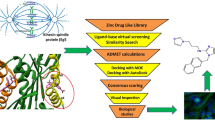Abstract
π–π Interaction is a direct attractive non-covalent interaction between aromatic moieties, playing an important role in DNA stabilization, drug intercalation, etc. Aromatic rings interact through several different conformations including face-to-face, T-shaped, and offset stacked conformation. Previous quantum calculations indicated that T-shaped and offset stacked conformations are preferred for their smaller electron repulsions. However, substitution group on aromatic ring could have a great impact on π–π interaction by changing electron repulsion force between two rings. To investigate π–π interaction between ligand and aromatic side chain of protein, Brookhaven Protein Data Bank was analyzed. We extracted isolated dimer pairs with the aim of excluding multiple π–π stacking effects and found that T-shaped conformation is prevalent among aromatic interaction between phenyl ring of ligand and protein, which corresponds with the phenomenon of Phe–Phe interactions in small peptide. Specifically, for the non-substitution model, both Phe–Phe and Phenyl–Phe exhibit a favored T-shaped conformation whose dihedral angle is around 50°–70° and centroid distance is between 5.0 and 5.6 Å. However, it could be changed by substituent effect. The hydroxyl group could contact in the case of Tyr–Tyr pairs, while they point away from phenyl plane in Phe–Tyr pairs.











Similar content being viewed by others
References
Hunter CA, Lawson KR, Perkins J, Urch CJ (2001) Aromatic interactions. J Chem Soc Perkin Trans 2:651–669
Saenger W (1984) Principles of nucleic acid structure. Springer, New York, pp 132–140
Wakelin LPG (1986) Polyfunctional DNA intercalating agents. Med Res Rev 6(3):275–340
Brana MF, Cacho M, Gradillas A, Pascual-Teresa B, Ramos A (2001) Intercalators as anticancer drugs. Curr Pharm Des 7(17):1745–1780
Kryger G, Silman I, Sussman JL (1999) Structure of acetylcholinesterase complexed with E2020 (Aricept): implications for the design of new anti-Alzheimer drugs. Structure 7(3):297–307
Desiraju GR, Gavezzotti A (1989) From molecular to crystal structure; polynuclear aromatic hydrocarbons. J Chem Soc Chem Commun 10:621–623
Burley SK, Petsko GA (1988) Weakly polar interactions in proteins. Adv Protein Chem 39:125–189
Wang YZ, Wu AX (2008) π–π interaction in aromatic supramolecular system. Chin J Org Chem 28(6):997–1011
Waters ML (2002) Aromatic interactions in model systems. Curr Opin Chem Biol 6(6):736–741
Hunter CA, Sanders JKM (1990) The nature of π–π interactions. J Am Chem Soc 112(14):5525–5534
Meyer EA, Castellano RK, Diederich F (2003) Interactions with aromatic rings in chemical and biological recognition. Angew Chem Int Ed Engl 42(11):1210–1250
Ye XY, Li ZH, Wang WN, Fan KN, Xu W, Hua ZY (2004) The parallel π–π stacking: a model study with MP2 and DFT methods. Chem Phys Lett 397(1):56–61
Tsuzuki S, Honda K, Uchimaru T, Mikami M, Tanabe K (2002) Origin of attraction and directionality of the π/π interaction: model chemistry calculations of benzene dimer interaction. J Am Chem Soc 124(1):104–112
Boehr DD, Farley AR, Wright GD, Cox JR (2002) Analysis of the π–π stacking interactions between the aminoglycoside antibiotic kinase APH(3′)-IIIa and its nucleotide ligands. Chem Biol 9(11):1209–1217
Wu JI, Puhlhofer FG, Schleyer PV, Puchta R, Kiran B, Mauksch M, Hommes NJRV, Alkorta I, Elguero J (2009) The effect of perfluorination on the aromaticity of benzene and heterocyclic six-membered rings. J Phys Chem A 113(24):6789–6794
Rashkin MJ, Waters ML (2002) Unexpected substituent effects in offset π–π stacked interactions in water. J Am Chem Soc 124(9):1860–1861
Tsuzuki S, Honda K, Azumi R (2002) Model chemistry calculations of thiophene dimer interactions: origin of π-stacking. J Am Chem Soc 124(41):12200–12209
Wheeler SE, Houk KN (2008) Substituent effects in the benzene dimer are due to direct interactions of the substituents with the unsubstituted benzene. J Am Chem Soc 130(33):10854–10855
Cockroft SL, Hunter CA (2009) Desolvation and substituent effects in edge-to-face aromatic interactions. Chem Commun 26:3961–3963
Hunter CA, Singh J, Thornton JM (1991) π–π interactions: the geometry and energetics of phenylalanine-phenylalanine interactions in proteins. J Mol Biol 218(4):837–846
Burley SK, Petsko GA (1985) Aromatic–aromatic interaction: a mechanism of protein-structure stabilization. Science 229(4708):23–28
McGaughey GB, Gagne M, Rappe AK (1998) π-stacking interactions. Alive and well in proteins. J Biol Chem 273(25):15458–15463
Thomas A, Meurisse R, Brasseur R (2002) Aromatic side-chain interactions in proteins II. Near- and far-sequence Phe-X pairs. Proteins Struct Funct Genet 48(4):635–644
Hendlich M, Bergner A, Gunther J, Klebe G (2003) Relibase: design and development of a database for comprehensive analysis of protein-ligand interactions. J Mol Biol 326(2):607–620
Gunther J, Bergner A, Hendlich M, Klebe G (2003) Utilising structural knowledge in drug design strategies: applications using relibase. J Mol Biol 326(2):621–636
Bergner A, Gunther J, Endlich M, Lebe G, Erdonk M (2001) Use of Relibase for retrieving complex three-dimensional interaction patterns including crystallographic packing effects. Biopolymers 61(2):99–110
Arunan E, Gutowsky HS (1993) The rotational spectrum, structure and dynamics of a benzene dimer. J Chem Phys 98(5):4294–4296
Meurisse R, Brasseur R, Thomas A (2003) Aromatic side-chain interactions in proteins. Near- and far-sequence His-X pairs. Biochim Biophys Acta 1649(1):85–96
Dahl T (1994) The nature of stacking interactions between organic molecules elucidated by analysis of crystal structures. Acta Chem Scand 48:95–106
Tauer TP, Sherrill CD (2005) Beyond the benzene dimer: an investigation of the additivity of π–π interactions. J Phys Chem A 109(46):10475–10478
Acknowledgments
We are grateful to Dr. En Li of China Novartis for his support and encouragement. Financial support from the Educational Office of Novartis Institutes for BioMedical Research is gratefully acknowledged. We also wish to thank Timothy Yu for his re-checking of the data reported in some of the Tables during his internship day at Fudan University.
Author information
Authors and Affiliations
Corresponding authors
Rights and permissions
About this article
Cite this article
Zhao, Y., Li, J., Gu, H. et al. Conformational Preferences of π–π Stacking Between Ligand and Protein, Analysis Derived from Crystal Structure Data Geometric Preference of π–π Interaction. Interdiscip Sci Comput Life Sci 7, 211–220 (2015). https://doi.org/10.1007/s12539-015-0263-z
Received:
Revised:
Accepted:
Published:
Issue Date:
DOI: https://doi.org/10.1007/s12539-015-0263-z




